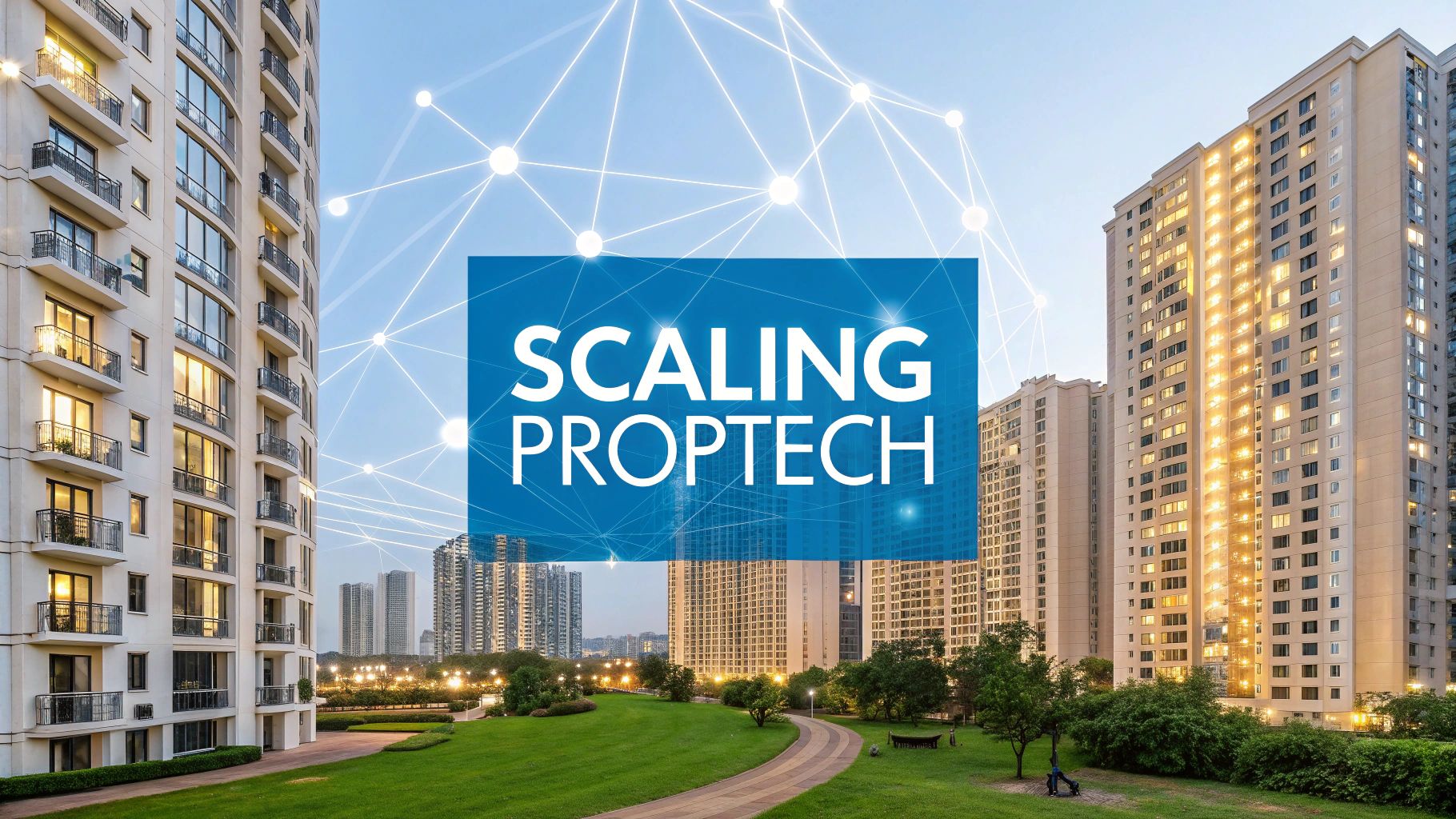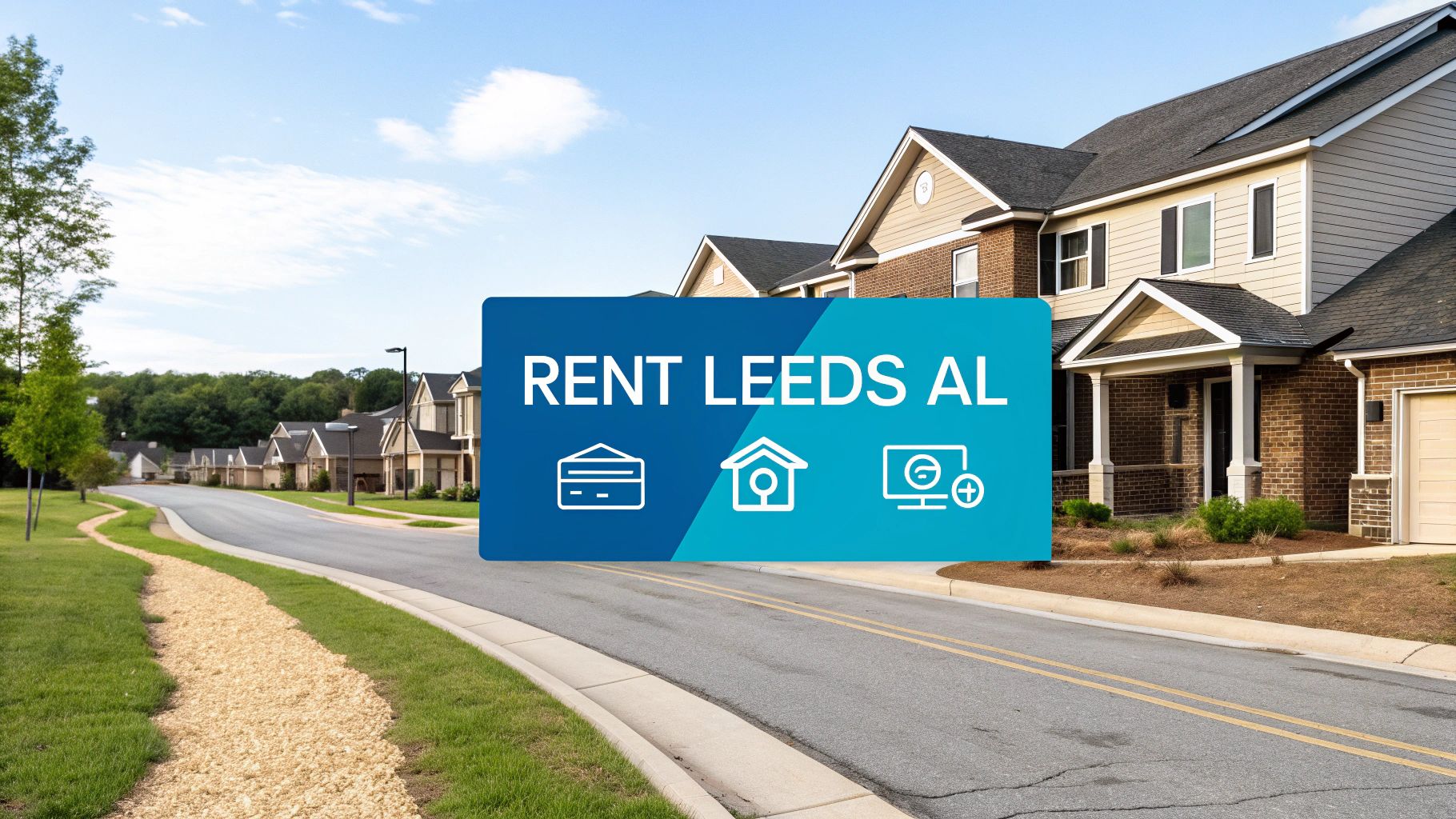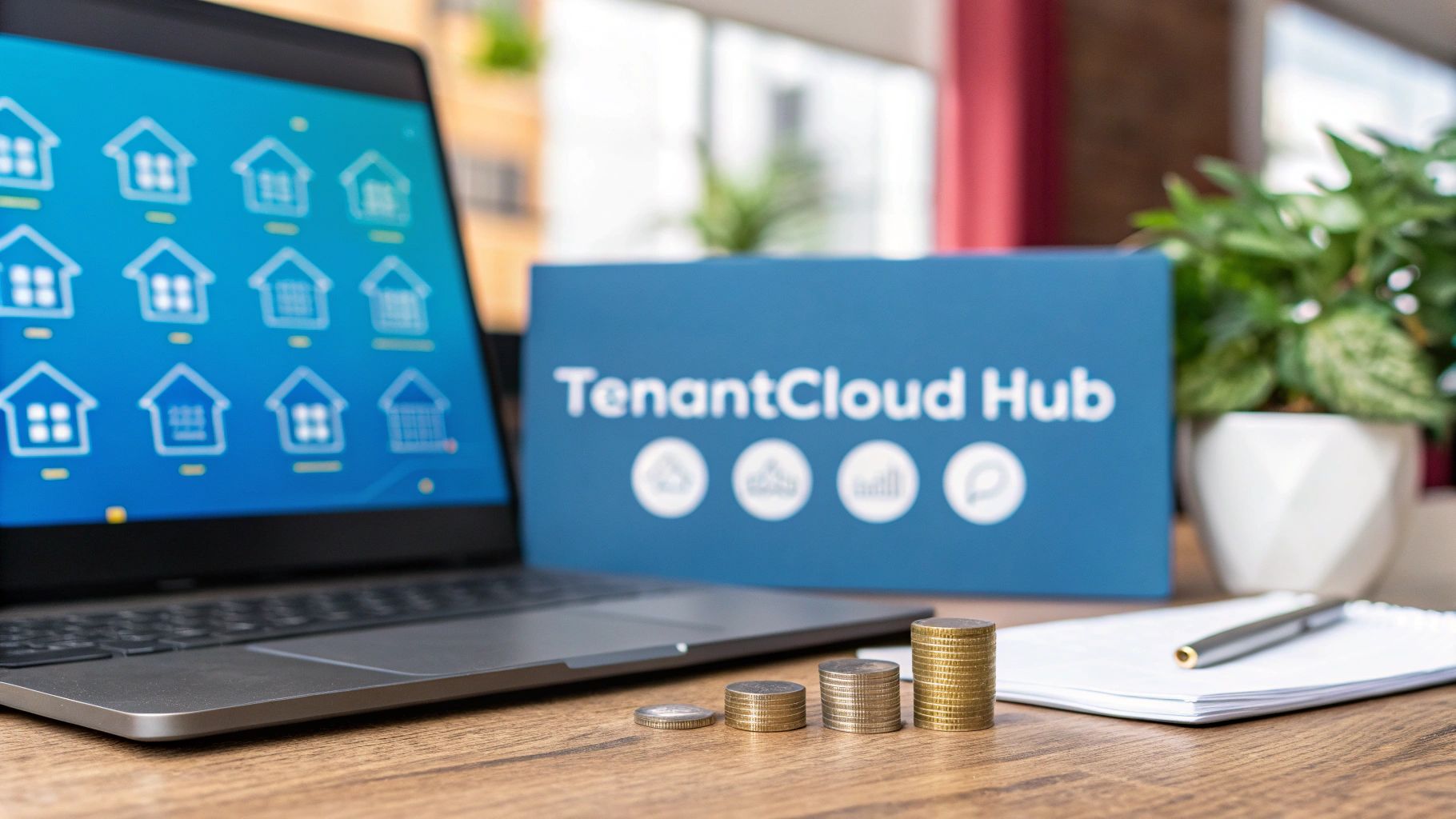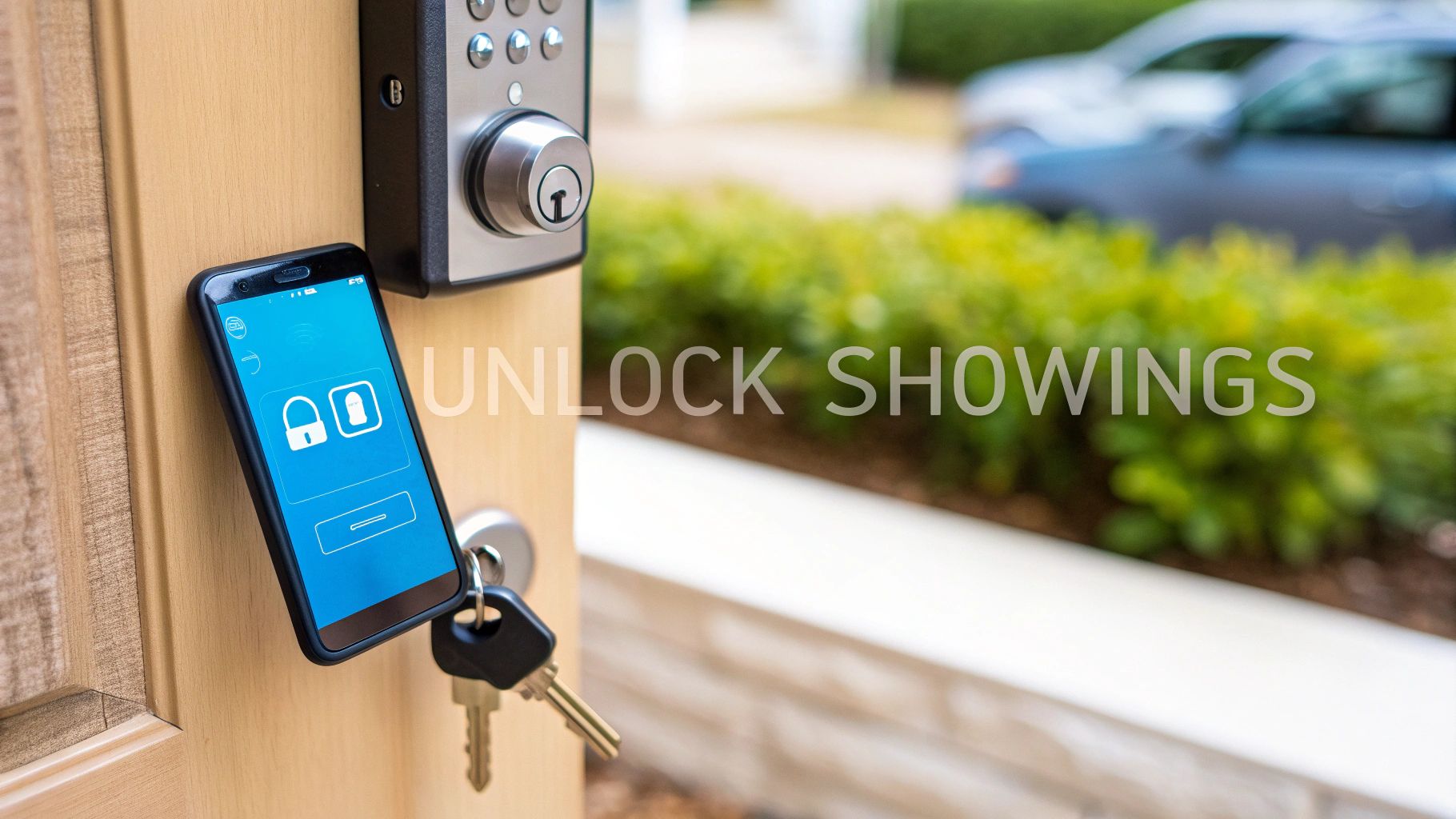At its core, property management tech is the ecosystem of software and hardware built to automate and sharpen the financial, operational, and leasing sides of a rental portfolio. For companies managing 100 to 10,000+ units, this isn't about convenience—it's the strategic engine that centralizes control, slashes cost per door, and dramatically speeds up the leasing cycle across geographically dispersed properties.
The New Rules of Large-Scale Property Management
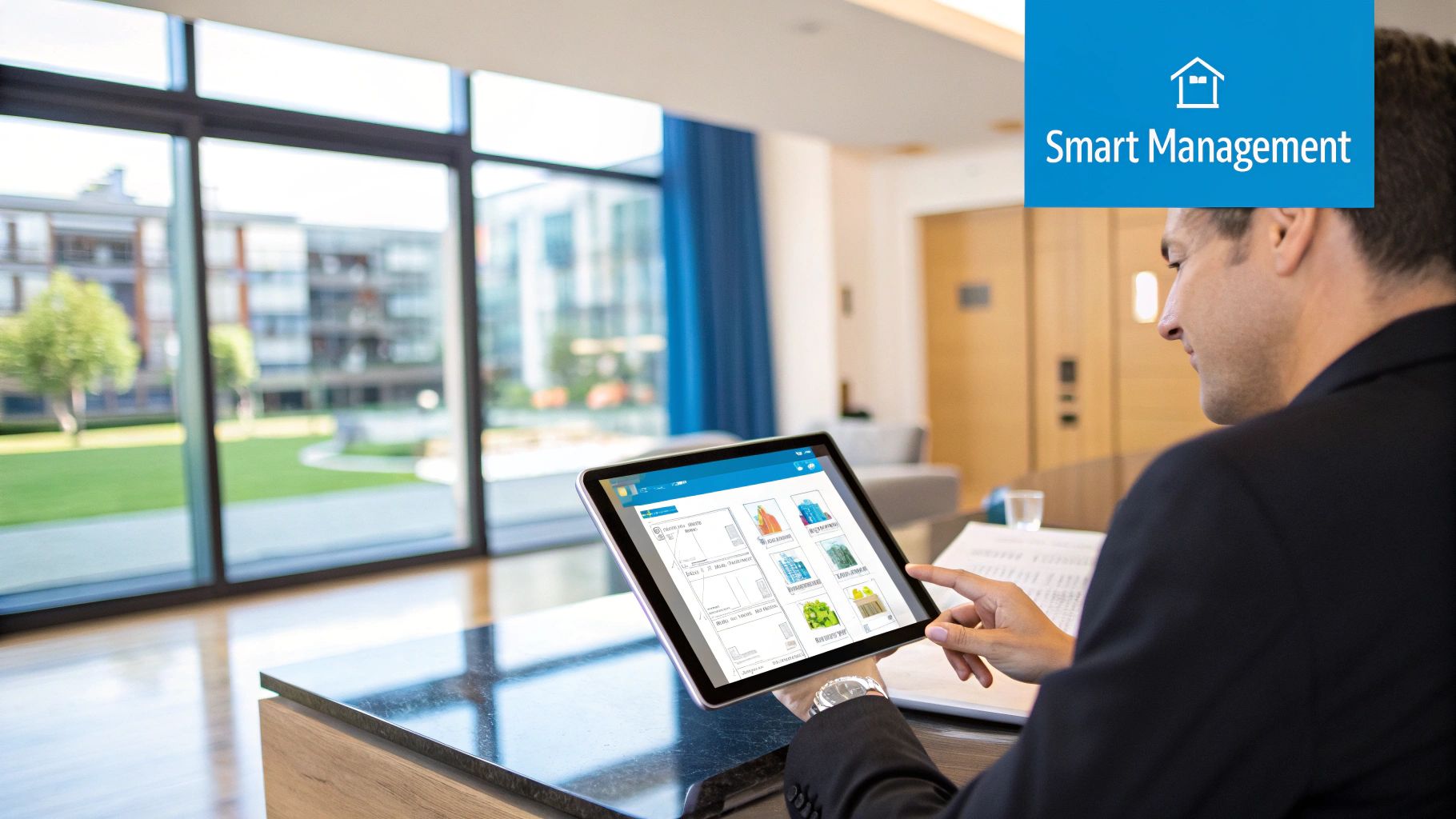
Managing a few rental properties is a game of tasks. Managing a multi-market portfolio of hundreds or thousands? That’s a game of systems.
The hands-on strategies that work for a small portfolio completely fall apart at scale. They create operational bottlenecks that bleed your bottom line through vacancy loss and inefficiency. At the enterprise level, every minor friction point gets magnified, turning small delays into significant financial drains that impact your net operating income (NOI).
This is where modern property management tech completely rewrites the playbook. It's far more than a box of digital tools for automating a few tasks. It’s the central nervous system for your entire operation, linking scattered properties, remote teams, and siloed data streams into one cohesive, intelligent framework.
From Manual Mayhem to Systemized Operations
The biggest hurdle for any large-scale operator is standardizing processes for consistency and profitability across a distributed portfolio. Without the right tech, workflows become fragmented, data gets locked away in different spreadsheets, and gaining a clear, real-time view of portfolio performance is impossible.
This leads to common growing pains that directly impact your most critical metrics:
- Scattered Leasing Workflows: When regional teams have their own methods for handling leads and scheduling tours, your lead-to-tour conversion rates become inconsistent and difficult to optimize.
- Crushing Operational Drag: Manually coordinating showings, inspections, and maintenance calls across hundreds of units consumes thousands of payroll hours and grinds unit turns to a halt, inflating your Days on Market (DOM).
- Delayed Decisions: Without real-time, portfolio-wide data, leadership is flying blind. You can't spot performance gaps, benchmark against market trends, or make agile strategic adjustments.
The real job of enterprise-level property management tech is to replace manual chaos with standardized, automated, and measurable systems. It’s about building an operational machine that runs like clockwork, whether you’re managing 500 units or 5,000.
This shift allows your teams to stop wrestling with low-value logistical tasks and start focusing on high-impact activities that drive revenue growth and resident retention.
A Strategic Engine for Revenue Growth
When you get right down to it, the best property management technology is a strategic engine built to attack your single biggest financial leak: vacancy loss.
Every single day a unit sits empty, you’re losing revenue you can never get back. For a large portfolio, that loss adds up terrifyingly fast. For example, if your average rent is $2,000/month, each vacant day costs you ~$67. Across a 1,000-unit portfolio with a 5% vacancy rate, that's over $100,000 in lost revenue every month.
Modern tech fights this by zeroing in on speed-to-lease. By automating lead responses, offering on-demand tour scheduling, and streamlining the application process, you eliminate the friction that causes qualified leads to go cold. It’s a systematic approach designed to aggressively shrink your Days on Market (DOM), ensuring you can convert a hot lead into a signed lease before the competition.
Building Your Enterprise Tech Stack
A powerful enterprise tech stack isn’t a random assortment of software. It’s a carefully architected ecosystem where every component works in concert to solve a specific scaling challenge. For property managers juggling vast, multi-market portfolios, this foundation rests on four key pillars.
Each pillar is designed to crush operational bottlenecks and directly boost the KPIs that move the needle—from Days on Market (DOM) and lead-to-tour conversion to your overall cost per door.
Let's walk through the blueprint for building a tech stack that drives scalable efficiency and growth.
Pillar 1: Leasing and Marketing Automation
The first pillar is about one thing: filling your pipeline with qualified leads and converting them faster than anyone else. This is more than just listing syndication; it's a high-performance engine built specifically to attack vacancy loss.
Its core function is to automate every step from initial inquiry to a completed tour. At scale, the sheer volume of leads can bury even the most organized teams. Automation ensures every prospect gets an immediate, professional response, preventing valuable leads from slipping through the cracks.
- KPI Impact: This pillar is laser-focused on DOM reduction and boosting lead-to-tour conversion rates. By automating responses and offering instant scheduling, you capture high-intent leads before competitors can.
- Bottleneck Solved: It eliminates the manual, time-consuming work of lead follow-up and tour coordination, a major operational drag for any leasing agent managing a large, distributed portfolio.
Pillar 2: Operations and Maintenance Management
Once a lease is signed, the game shifts to operational excellence. This pillar encompasses the technology that keeps your properties running smoothly, from a simple maintenance request to a full unit turn. For remote property management operations without onsite staff, these tools are non-negotiable.
They act as a central command center for scheduling vendors, tracking work orders, and ensuring quality control from afar. This systemization prevents small issues from escalating into costly repairs and ensures unit turnovers happen on a predictable, rapid schedule. This is where a deep understanding of the best property management software becomes a true competitive advantage.
Pillar 3: Financial and Analytics Platforms
You can't optimize what you can't measure. The third pillar is the brain of your operation, pulling financial and operational data from every corner of your portfolio into a single source of truth. These platforms go beyond simple accounting to deliver powerful business intelligence.
This is the tech that lets you analyze performance by market, property type, or even individual unit. It’s how you spot trends, forecast revenue, and make strategic decisions backed by hard data, not just intuition.
For enterprise-level operators, this is where you transition from managing properties to managing a high-performance asset portfolio. It provides the clarity needed to optimize your cost per door and maximize net operating income.
This simple diagram shows how today's property management tech uses a central dashboard to give teams mobile access while providing critical analytics to leadership.

The image highlights a key principle: true operational control comes from unifying field activities with strategic office insights, all within one accessible system.
Pillar 4: Resident Experience Tools
The final pillar focuses on your most valuable asset: your residents. This tech is dedicated to improving communication, simplifying payments, and offering services that boost satisfaction and retention.
High turnover is a financial killer, driving up marketing and unit-turn costs. Tools like resident portals for maintenance requests, platforms for online rent payments, and community communication tools make tenants feel heard and valued, increasing the likelihood of renewal.
- KPI Impact: This technology directly improves resident retention rates, slashing the significant costs associated with unit turnover.
- Bottleneck Solved: It replaces inefficient, one-off communication methods like phone calls and emails with a scalable, trackable system that delivers superior service.
Each of these pillars works together to create a solid foundation for growth. Here's a quick summary of how they fit together.
Four Pillars of Enterprise Property Management Technology
By architecting your tech stack around these four pillars, you can build a system that doesn’t just support your current operations—it actively fuels your ability to scale profitably.
How Automation Accelerates Your Speed-to-Lease
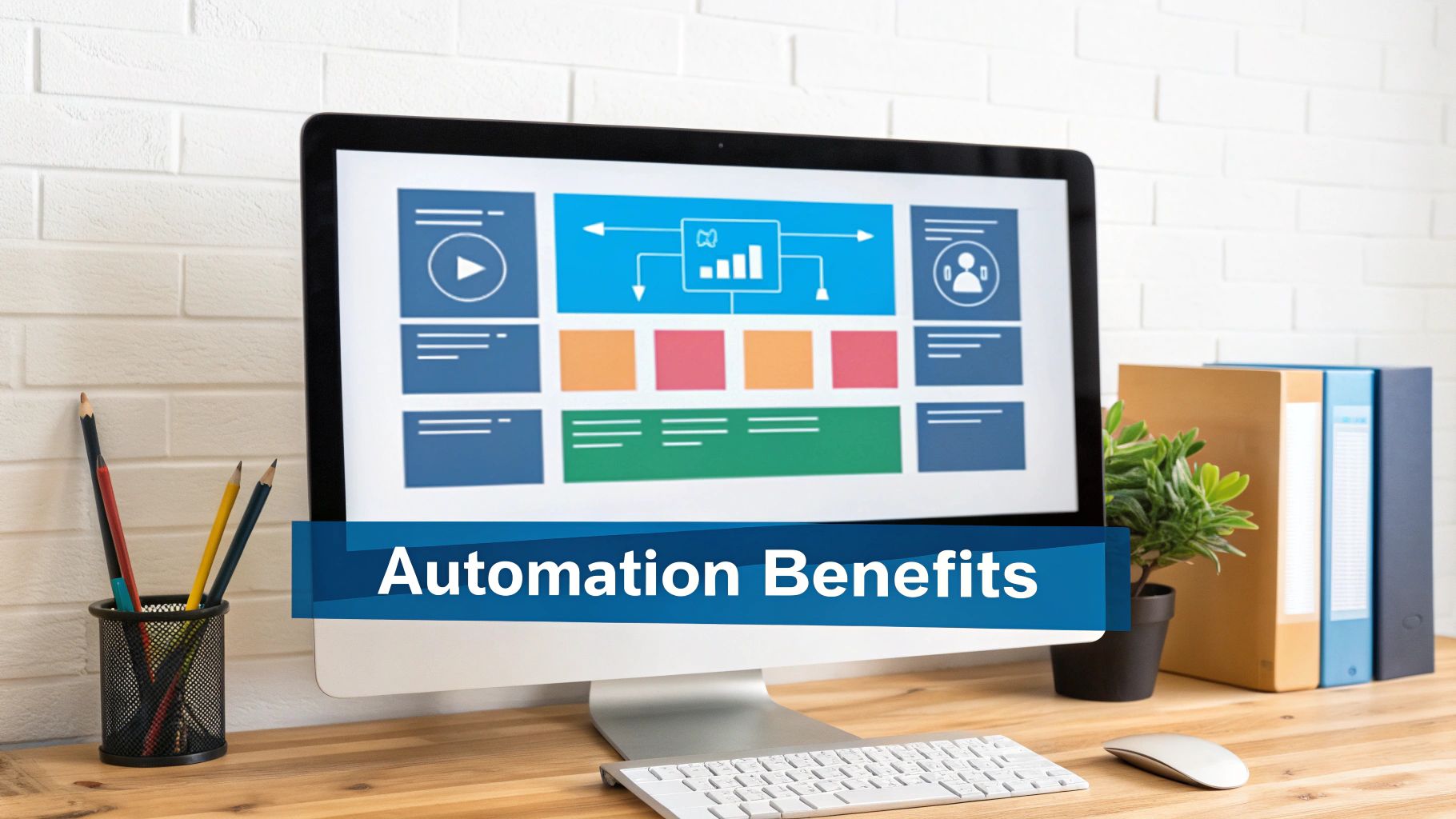
When managing a large-scale portfolio, the biggest threat to your bottom line isn’t a shifting market—it's vacancy. Every day a unit sits empty is an irreversible loss of income. That financial leak, multiplied across hundreds or thousands of doors, can snowball into a six- or seven-figure problem annually.
The solution isn't to work harder; it's to work faster. Property management tech tackles this head-on by using automation to compress the leasing timeline. It's all about converting high-intent prospects into signed tenants in record time—the core of optimizing for speed-to-lease.
The High Cost of a Slow Leasing Cycle
Before diving into the tech, let's quantify the problem. A slow, manual leasing process is riddled with friction points that add days—and sometimes weeks—to your Days on Market (DOM).
Consider the financial drag. If your portfolio's average monthly rent is $2,200, the daily cost of vacancy per unit is over $73. Shaving just five days off your average DOM for 500 turnovers a year adds up to $182,500 in recovered revenue. For a portfolio with 2,000 annual turnovers, that number skyrockets to a staggering $730,000.
This isn't just an operational metric; it's a core financial performance indicator. Reducing DOM is one of the most direct ways to boost Net Operating Income (NOI) without raising rents or acquiring new properties.
Automation flips the script by targeting the two biggest time-wasters in the leasing journey: lead response and tour scheduling.
From Lead to Tour in Minutes, Not Days
In a competitive rental market, speed is non-negotiable. A prospect's interest peaks in the first few minutes after they inquire. Research from Zillow shows that renters who tour a property are twice as likely to apply if they hear back from the property manager within the first 24 hours. Wait longer, and you've given them time to find and schedule a tour with a competitor.
This is where automation delivers its first major win. Smart CRMs and automated communication tools ensure every lead gets an immediate, professional response, 24/7.
- Instant Engagement: Automated emails or texts instantly confirm interest and guide the prospect to the next step, capturing their attention while it's hot.
- Intelligent Qualification: Systems can ask pre-screening questions automatically, filtering for qualified renters and prioritizing leads for your team.
- Seamless Scheduling: The most powerful move is linking the initial response directly to an automated tour scheduling platform like Showdigs. Prospects can book a showing instantly.
This workflow eliminates the frustrating game of phone tag that plagues leasing agents. It transforms a multi-day back-and-forth into a smooth, five-minute interaction that sends your lead-to-tour conversion rates soaring. To dig deeper, you can see how marketing automation streamlines your leasing process.
On-Demand Showings: The Final Piece of the Puzzle
Once the tour is scheduled, the next bottleneck is agent availability. In a distributed portfolio, coordinating staff for showings across a wide geographic area is a logistical nightmare that inevitably causes delays.
On-demand showing solutions complete the automation loop. By leveraging a network of vetted, local agents or enabling secure self-showings, you can offer prospects nearly instant access to your properties. This tech allows you to:
- Offer Same-Day Tours: Fulfill prospect requests for immediate showings—a massive competitive advantage.
- Eliminate Windshield Time: Free your in-house team from spending hours driving between appointments.
- Scale Across Markets: Easily manage showings in new regions without hiring full-time, on-the-ground staff.
To get a better sense of how different solutions can improve operations, exploring various small business automation tools can offer great insights into cutting down your speed-to-lease.
Real-World Impact: A Mini-Case Study
A multi-market operator managing over 2,500 single-family rentals was stuck with an average DOM of 38 days. Their leasing process was entirely manual, with a central team trying to coordinate showings with regional staff, creating huge delays.
By implementing an automated, on-demand showing platform, they completely re-engineered their workflow. Leads were automatically funneled into a self-scheduling system, and a network of local agents handled the tours. The results were immediate and dramatic.
Within six months, their average DOM plummeted from 38 days to just 21—a 45% reduction. This didn't just save thousands in vacancy loss per unit; it also freed up their internal team to focus on high-value work like lease negotiations and owner relations, boosting overall portfolio performance. It’s a perfect example of how the right property management tech delivers a powerful and measurable ROI.
Why Integrated Platforms Are Winning
In property management, siloed software is the enemy of scale. When you’re juggling one tool for listings, another for maintenance, and a handful of spreadsheets to track leads, you're creating data chaos. This patchwork approach forces your team into endless manual data entry—a recipe for costly mistakes and a blurry, outdated view of your portfolio.
The market has decisively moved away from this scattered model. The most successful large-scale operators are building their operations on unified, cloud-based platforms. These systems act as a single source of truth for the entire business. This isn't a trend; it's the new standard for managing a multi-market portfolio effectively.
When your teams are spread out across different locations, real-time data access isn't a luxury—it's essential. An integrated system ensures that everyone, from the leasing agent in the field to the COO at headquarters, is working from the same up-to-date information.
The Power of Seamless API Integrations
The magic behind these modern platforms is their Application Programming Interfaces (APIs). An API acts as a universal translator, allowing different software programs to communicate seamlessly. A platform with a robust API doesn't lock you into a rigid, one-size-fits-all solution. Instead, it lets you plug your favorite best-in-class tools directly into your core Property Management System (PMS).
This creates a powerful, interconnected ecosystem where data flows automatically between the apps you rely on.
- A prospect schedules a tour through your showing software? A new lead is instantly created in your CRM.
- A maintenance request is marked complete? The work order is automatically closed out in your operations platform.
- A new lease is signed? All financial data syncs directly with your accounting software.
This level of automation eliminates redundant tasks and ensures data integrity across your entire tech stack. For a deeper look at how different systems can be wired together, it's worth exploring various help desk integration strategies.
Driving Market Growth Through Connectivity
This shift toward integrated, cloud-based solutions is the single biggest force shaping the property management tech industry. This is especially true in North America, which holds about 35.5% of the global market. The region’s market size blew past USD 24 billion and is on track to top USD 26.5 billion by 2025, driven almost entirely by the rapid adoption of connected platforms. You can find more details on these property management market trends on fortunebusinessinsights.com.
An integrated platform is no longer just an operational expense; it's a competitive necessity. It is the only way to effectively standardize processes, maintain data accuracy, and drive efficiency as you scale from hundreds to thousands of units.
Ultimately, a cohesive platform transforms your technology from a messy collection of tools into a true strategic asset. It gives you the visibility and control needed to tighten up every part of your portfolio, from cutting your Days on Market (DOM) to optimizing your cost-per-door.
Implementing Technology Without Disrupting Operations
Rolling out new property management tech across a large, distributed portfolio can feel like changing the engine on a plane in mid-air. The fear of disrupting daily operations—from leasing to maintenance—is a massive hurdle for any leadership team. A misstep could create chaos for staff, frustrate residents, and negatively impact your bottom line.
However, a strategic, phased approach can turn a potentially disruptive transition into a smooth one that builds momentum. Success isn't about flipping a switch and hoping for the best; it's about meticulous planning, clear communication, and selecting the right technology partner.
The right partner understands the unique challenges of remote property management operations, recognizing that you lack onsite staff at every location and that seamless integration is non-negotiable.
Planning for a Phased Rollout
Attempting to launch a new system across thousands of units simultaneously is a recipe for disaster. A phased rollout minimizes risk and allows your team to adapt without being overwhelmed.
A proven rollout framework looks like this:
- Phase 1: The Pilot Program. Start small. Select a representative sample of properties, perhaps 50-100 units in a single market, to test the new technology. This controlled environment lets you identify and resolve workflow kinks before they affect your entire portfolio.
- Phase 2: Regional Expansion. Once the pilot proves successful and ROI is validated, expand to an entire region or market. This step stress-tests the system at a higher volume and helps you standardize training and implementation processes.
- Phase 3: Portfolio-Wide Deployment. With proven workflows, validated ROI, and internal champions from the pilot regions, you can confidently roll the technology out across the remaining portfolio.
This methodical approach transforms a daunting project into a series of manageable wins. It's how you can https://www.showdigs.com/property-managers/improve-property-management-operations without causing an operational meltdown.
The Make-or-Break Factors for Success
Beyond the rollout plan, several factors will determine if your new tech implementation succeeds or fails.
Robust API and Clean Data Migration
Your new tool is only as good as its ability to communicate with your core Property Management System (PMS). Before committing, rigorously vet the vendor’s API capabilities. A weak or clunky API creates data silos and forces manual workarounds, negating the benefits of the new tech. Ensure a clear, painless plan is in place to migrate historical and active data accurately.
Real-World Team Training and Buy-In
Technology is useless if your team doesn't know how—or doesn't want—to use it. Training must be hands-on and role-specific, supported by clear documentation and internal "super-users" who can champion the new system. Getting your leasing agents, portfolio managers, and maintenance coordinators excited about how the new tool makes their jobs easier is essential for adoption.
As you bring new systems online, it is also a critical time to review and tighten your data security best practices. Protecting sensitive resident and owner information is paramount during any technology transition.
Got Tech Questions? We’ve Got Answers.
Adopting new property management tech can feel overwhelming. With countless options, it's easy to get analysis paralysis. We hear the same high-stakes questions from enterprise operators all the time—concerns about implementation, ROI, and whether a tool can truly scale.
Here are the straight answers to the most common questions from managers overseeing large, distributed portfolios.
What’s the Biggest Mistake Operators Make When Choosing New Proptech?
Hands down, the most common pitfall is chasing a long list of shiny features instead of focusing on deep, seamless integration with your core Property Management System (PMS). It's a classic case of quantity over quality.
A tool that perfectly syncs with your system of record is a strategic asset. A feature-packed platform that creates data silos and more manual work is just a high-tech liability.
At scale, even minor workflow friction gets magnified across thousands of units, creating massive inefficiencies. Always start by mapping your core operational processes. Then, vet any new tech based on how well its API automates those specific workflows.
How Do We Actually Calculate the ROI of New Leasing Technology?
You don't need a complex formula to build a clear financial case. It boils down to three core metrics that directly impact your P&L.
- Revenue Recovered from DOM Reduction: Calculate your average daily rent and multiply it by the number of vacancy days saved per lease. Across your portfolio, this represents direct revenue recovery. (Vacancy Days Saved x Daily Rent) x Annual Turnovers = Total Recovered Revenue.
- Lower Cost Per Lease: Improved efficiency means higher lead-to-tour conversion rates. This allows you to generate more leases from your existing marketing spend, effectively lowering your cost of customer acquisition.
- Operational Savings: Quantify the payroll hours saved on low-value, repetitive tasks like manual tour scheduling, follow-up emails, and agent drive time. This represents a hard-dollar reduction in operating expenses.
Summing up the new revenue and direct cost savings provides a clear, compelling ROI that resonates with stakeholders.
What Really Separates Enterprise Tech from Tools for Small Landlords?
The key differentiators are scalability, integration, and analytics. Technology for small landlords is typically a closed, all-in-one system designed for a handful of properties.
Enterprise property management tech, in contrast, is architected around a powerful, open API that allows you to integrate best-in-class tools with your central PMS. It’s engineered to standardize operations across thousands of units, manage complex user permissions for large teams, and deliver the sophisticated, portfolio-wide business intelligence needed to drive performance.
Understanding this distinction is critical for supporting remote property management operations and achieving true cost per door optimization as you scale.
Ready to slash your Days on Market and put your leasing operations on autopilot? Showdigs is the only platform that combines powerful automation with an on-demand network of showing agents to fill your vacancies faster across any market. Book a demo today to see how it works.




